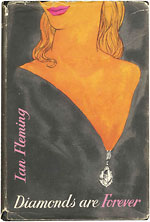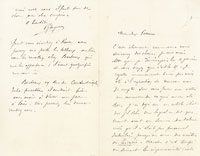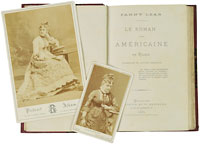Personality Abounds: An American Adventuress, A Sulking Painter, A Poetic Bad Boy, and a Fashion-Forward King
Diamonds for Ulrica, the Typing Bond Girl
Diamonds are Forever, Bonhams London on November 10, $25,895 & $103,585
Inscribed “To Rica, who wrote it, from Ian Fleming,” a 1956 first edition of Diamonds are Forever was given to his secretary, Ulrica Knowles, and the inscription jokingly acknowledges the fact that she had typed out the text used by his publishers, Jonathan Cape. It sold for $25,895 (£15,600).
The book had originally been typed by Fleming himself at his Jamaican home, Goldeneye, and both the top and carbon copies of that version are now in the Lily Library at the University of Indiana—the repository of most of Fleming’s manuscripts and typescripts. At this same sale, the version that Ulrica had typed out for Cape’s proofreaders reached $103,585 (£62,400).
Marked “To be returned to the author for final revision,” it contains Fleming’s autograph revisions throughout. Some are seemingly inconsequential–the alteration of a telephone number, for example–but others suggest a rethink or an attempt to add color, even to flesh a minor character.
When Bond checks into the Hotel Astor it was originally to be “in front of an elderly woman,” but he changed it to “before a hatchet-faced woman with a bosom like a sandbag.”
Gauguin is Nagged all the way to the South Seas
Paul Gauguin Autograph Letter, Bonhams Los Angeles & New York on October 19, $31,720
His wife and children eventually left to seek financial security with her family, leaving him free to take himself off to the South Seas and paint, but in a letter of c.1883, a struggling, frustrated, and mercilessly nagged Gauguin unloads his troubles on his friend and fellow artist, Camille Pissarro.
“I very much regret not having made it to the Manet exhibition but … I’ve already seen an idiotic article … in which they say that all in all Manet had talent but it wasn’t his own. Imbeciles! Because one loves the masters, one copies them. Manet was wrong to follow the Impressionists … You have to resign yourself to the inevitable: you only have talent once you’re dead.”
Gauguin also bemoans his domestic and financial situation. “Here, my wife is intolerable–finds fault in everything–sees no light at the end of the tunnel … My meagre savings are seriously dented and I’ve got enough to live on for six months at most. As for business … I absolutely must succeed with painting. On this front, my sister and plenty of others have of course sided with my wife, and so I don’t have an ounce of talent … I’m writing to you from the midst of penetrating baby screams and many other embarrassing things which might make what I’m writing incomprehensible.”
Fanny and the Disgraced Grand Duke
An American in Russia, Dominic Winter South Cerney on November 4, $215
First published in Brussels in 1875, Le Roman d’une Americaine en Russie, relates the adventures and travels in Russia and Europe of Fanny Lear, or Harriet Blackford as she was known back home in Philadelphia.
The indiscretions of this American adventuress included an affair with a grandson of Tsar Nicholas I, the dangerously liberal Grand Duke Nicholas Konstantinovich. A subsequent scandal–linked to the planned theft of some Romanov jewels–resulted in the dallying duke being banished from court and effectively written out of Romanov history.
Bound in red half morocco of the period, this copy contained both an inscription to a Monsieur Baudier, signed Fanny Lear, and an autograph letter sent in 1895 from London’s Grosvenor Hotel in which the writer comers clean and signs herself Hattie Blackford. It also contains two loosely inserted cabinet card portraits of the author.
The story of Fanny and the Duke has more recently formed the basis of a novel by another aristocrat of ancient Romanov blood, Prince Michael of Greece. Again, it was first published in French, but in 2005 an English version appeared as The White Knight of St Petersburg. An amusing review of Prince Michael’s book by Peter Kurth, published in the Toronto Globe & Mail, gives more details of Fanny’s amours and misdemeanors.








 Ian McKay’s weekly column in Antiques Trade Gazette has been running for more than 30 years.
Ian McKay’s weekly column in Antiques Trade Gazette has been running for more than 30 years.

